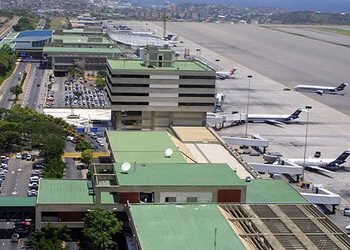The seizure of a three-ton cocaine shipment at a major Venezuelan airport highlights the role of airport infrastructure in international drug trafficking and exposes an unusual drug trafficking route.
On August 24, the Bolivarian National Guard (GNB) seized three tons of cocaine that was to be shipped on an EMTRASUR (a state-owned Venezuelan airline) cargo flight from the Simón Bolívar International Airport of Maiquetía, located in the state of La Guaira, near Caracas. The shipment was destined for Afghanistan but was to make a stopover in Russia, according to a media report.
Authorities arrested 13 people following the drug seizure. Of those, three were identified as responsible for coordinating the entry of the substance from Colombia through the border state of Táchira and its transfer by land to the airport. The cocaine was hidden in packages associated with the company Café El Faraón C.A., whose owner reportedly fled to Colombian soil following the drug seizure.
SEE ALSO:Venezuela’s Cocaine Revolution
Although the initial report indicated that the president of the State Company Aerocargo del Sur (EMTRASUR), César José Pérez Salas, had been captured, the Venezuelan Minister of Transport, Ramón Celestino Velásquez, later denied this version in his X account.
To date, apart from Velasquez, no other official Venezuelan government source has commented on the seizure.
Following the seizure, journalist Sebastiana Barráez told InSight Crime that “it is not possible that drug shipments could leave Maiquetia International Airport without the complicity of the security forces, specifically the Armed Forces, because the airport is totally under government control.
The last time Maiquetia Airport was involved in such a large volume shipment was in 2013, when French authorities seized 1.3 tons of cocaine introduced in 31 suitcases on a commercial flight of the Air France airline.
InSight Crime Analysis
While this is not the first time Maiquetia Airport has been used in attempts to export cocaine to unusual foreign destinations, sending such a large shipment to a country like Afghanistan could be a cover for other lucrative drug trafficking routes to Asia.
Historically, Afghanistan was the world’s main center of opium production and trafficking, accounting for almost 80% of the global supply. However, its role in the drug trade has changed substantially in recent years. Opium production in the country plummeted by 95%, falling from 6,200 tons in 2022 to just 333 tons in 2023, according to an August 2023 study by the United Nations Office on Drugs and Crime (UNODC).
The collapse in the opium market has given rise to new dynamics, such as the increase in trafficking of locally manufactured methamphetamines, with record seizures in Europe and Asia. Although Afghanistan has a history of drug trafficking, this is the first time a cocaine shipment from Latin America to Afghanistan has been recorded.
SEE ALSO:Mafia Boss Claims Venezuela-Turkey Cocaine Connection
Speaking to InSight Crime, Vanda Felbab-Brown, an organized crime expert and senior fellow at the Brookings Institute, said that using Afghanistan as a cocaine destination seems like a diversionary maneuver to ensure the arrival of shipments to other emerging destinations.
“It’s quite complicated to get through Afghanistan, and it almost seems like this was meant to be intercepted. It’s as if it’s a covert operation, where a counter-narcotics unit is testing the quality of the networks through controlled deliveries, or perhaps the drug traffickers are sending something they know will be intercepted while moving another shipment along a different route,” Felbab-Brown said.
On the other hand, the researcher points out that, if there is an interest in moving three tons of drugs to the Asian market, Turkey and Russia – where the flight would have a stopover – would be safer options with better connections to Venezuela for this type of operation. Both nations have established networks and specialized criminal organizations that guarantee more reliable transit.
“Turkish groups play an important role. They have expanded Latin American connections and have connections in Central Asia and, obviously, the Middle East, as well as Europe,” explained Felbab-Brown.
On the map of alternative destinations that have departed Venezuela, Turkey has positioned itself as an option to common destinations such as Europe and North America, where state surveillance and interdiction have led international organizations to seek new drug corridors.
In 2018, Venezuela’s Attorney General, Tarek William Saab, reported the dismantling of a transnational criminal network that sent drugs via commercial flights from Venezuela to Lebanon, Turkey, and some destinations in Europe. Among the 18 detainees who participated in that criminal enterprise was a second sergeant of the GNB assigned to the Special Anti-Drug Unit of the Airport.
Another of the most renowned cases is linked to the accusations of Sedat Peker, a mafia boss of Turkish origin, who accused Erkam Yildirim – son of former Turkish Prime Minister Binali Yildirim – of making several visits to Venezuelan soil with the aim of opening a new transnational drug transport line between South America and Turkey.
Although Peker’s accusations did not lead to official investigations, the commercial ties between the Venezuelan and Turkish governments, especially in the gold trade, could be exploited by Turkish criminal networks that have been gradually increasing their involvement in the cocaine trade.
Featured image: Simón Bolívar International Airport in Maiquetía. Credit: Wikimedia Commons
Source link : http://www.bing.com/news/apiclick.aspx?ref=FexRss&aid=&tid=66d5fcc6ee784dd5aeb209a95b562249&url=https%3A%2F%2Finsightcrime.org%2Fnews%2Fa-3-ton-cocaine-seizure-in-venezuela-highlights-asia-trafficking-routes%2F&c=14149210935469863123&mkt=en-us
Author :
Publish date : 2024-09-01 13:00:00
Copyright for syndicated content belongs to the linked Source.
